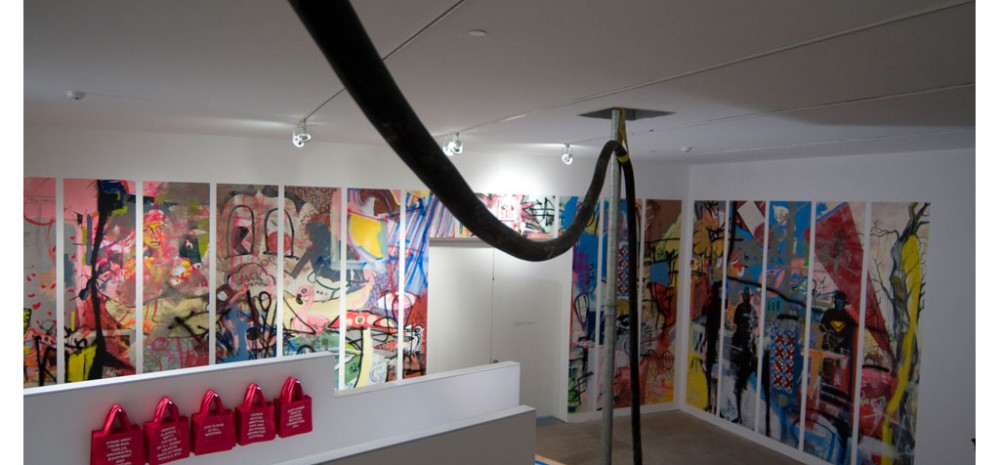Born in 1964 in Toronto, Ontario
Lives and works in Toronto
Scott Lyall
anatmospheric perspective / santa fe, 2008
From the mid-1930′s and throughout the Great Depression, more than sixty-five public mural projects were commissioned in New Mexico using federal money provided through the Works Progress Administration. About 167 artists lived in New Mexico at the time, and most were struggling to sell their work in a troubling economic climate. Many of their neighbors had little money for works of art, or even for necessaries like new clothing, nutritious food, or mortgage settlements. The WPA encouraged artists to work collectively in public settings, producing murals that married the ideals of their local communities with New Deal policies. Although some of the murals survived  and some have been transferred to museums — many others were painted out in the years that followed the Great Depression, and still a few others were lost to the wrecking ball and re-development. But more recently, many conservators have proposed remaking the destroyed murals, drawing on photographic documentation and historical expertise to replicate them. No longer considered the signs of bitter times  or nascent socialist organization — the new murals would take a place within New Mexico’s cultural heritage, to be reviewed and enjoyed by generations of residents, scholars, and tourists.
Using this history and its outcomes to map a conceptual structure, I plan to direct the communal performance of a mural, to be exhibited within the framework of Lucky Number Seven. The painting will be completed on SITE’s southwest perimeter wall by an assembly of local artists. I do not want to constrain this process by selecting its terms and references. Instructions such as verbal, syntactical, or otherwise will not be provided. Rather, the painters will be asked only to fill the designated wall area, in any way they consider relevant, personally challenging, or amusing. The painting will be developed as a collective improvisation, reflecting the resources of space and budget, the skill of the crew, and the limited time frame. Once the painting is completed, laser-perforated vinyl will be applied to completely cover the area filled with color by the assistants. The colors of the painting will still shine through the perforations, but now in a high state of abstract (static, or “statedâ€) organization.
The sum of these procedures is a kind of temporal montage. The work is designed so that an image of the mural painting will be visible only in the pages of the Biennial catalogue, in a section planned to document the real-time process of its installation. Therefore, it will not be a full presence for Biennial spectators. Its transformation under the vinyl will suggest a stage of pre-production, when the mural is “separated from the wall†in preparation for documentation. The perforated mask displaces the painted form into wallpaper, a decorative frieze merged with the other elements of exhibition design for the show. However, if the mural is expressly an object produced for documentation, it can also be re-made or re-collected at some other time, in other venues. I plan to enact this ongoing “potential†of destroyed painting at the Power Plant Gallery in Toronto, immediately following the Biennial.
I was interested in the proposal inherent in Lucky Number Seven that contemporary institutions might define themselves as the medium of works of art. But I mean medium in the way Marshall McLuhan once defined it: as a social metaphor and as a translator that aims to realize latent cultures. The colored dots I proposed are meant to specify this conception. They aren’t an homage to Sol Lewitt or Daniel Buren, or critical painting; they are just my little contemporaries: a pixilation of many perspectives. They are colored trade beads, a sum of money in a miser’s purse, a future’s market.
The mural is located on the south wall of Gallery 6.
Scott Lyall combines drawing, painting, sculpture, and found objects into spare yet complex sculptural environments. An intense period of research and digital image-making precedes his multifaceted projects that delve into themes such as the links between graphic processes, sculptural display, and the design legacies of Conceptualism. Lyall makes his sculptures from everyday materials like particle board and Styrofoam, incorporating ephemeral fragments, as well as mathematically-generated drawings and paintings, into his installations. The effect is one of improvisation and incompleteness married with calm predetermination.
Recently, Lyall has become interested in the conditions of theatricality and spectacle. a dancer dances (2006) takes its cue from the musical A Chorus Line to investigate forms of performance notation and the idea that “works of art are in progress: the real show is coming.†the little contemporaries (2007) was stimulated by an invitation to collaborate with dancer and choreographer Maria Hassabi. Lyall studied video footage of Hassabi’s rehearsals which he translated into figures and linear diagrams. He also ‘grabbed’ the light refracted from Hassabi’s leotard and displayed it as color gradients on a video monitor. Separated from its theatrical origins, the little contemporaries evoked the different temporalities and conditions of dance and sculpture.
With its condensed wit, elegant formalism, and deliberate opacity, Lyall’s work eschews straightforward interpretation and invites contemplation and exploration.
Gregory Burke
